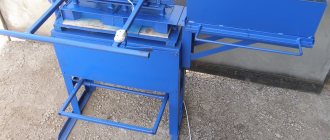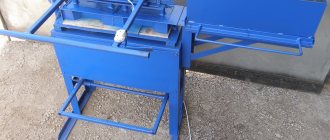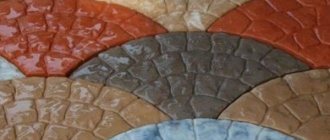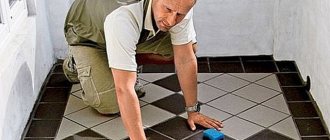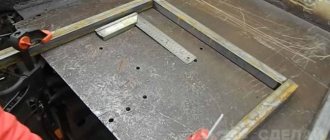The technology for making a homemade vibrating table for paving slabs will be useful for those who are planning to pave paths in the courtyard of an individual house. And also for private entrepreneurs who are ready to organize mini-production of tiles and paving stones for sidewalks and paths.
Paving slabs are a popular material among both public utilities and private homeowners. Easy to install, abrasion resistant, easy to maintain and other advantages of the tile have led to an increase in its popularity.
Many people, deciding to lay tiles on a large area, start making them themselves.
DIY vibration table for paving slabs
The main device that you need to buy to start the tile making process is a vibrating table. It is designed to compact the composition of the tile mold and remove air bubbles from it.
However, craftsmen also act independently here, preferring to make a vibration table with their own hands rather than buy a ready-made one. Moreover, you can make it from improvised means at home.
We will try to consider in detail how to make a vibration table with your own hands, in the form of step-by-step instructions.
What is a vibrating table for tiles?
Vibrating table or vibrating press
– this is equipment for the production of paving slabs. The working surface of the table can perform oscillatory movements; such vibration is its main advantage and purpose.
The vibrating table allows you to produce not only paving slabs, but also cast concrete fence sections, monuments, decorative elements, etc.
Vibrating table for tiles - types and types
To decide on the type of future equipment, you need to understand what vibrating tables exist and what the purpose of each type is:
Vibration direction:
Vibrating table with horizontal vibration; Vibrating table with horizontal vibration
Vibrating table with vertical vibrationVibrating table with vertical vibration
The direction depends on how the rotor is installed. The most widespread are tables with horizontal vibration.
By installation method:
- mobile (portable);
- stationary.
By specialization:
- molding Tables are designed for shaping the product;
- deforming (stripping). Purpose - to knock out (remove, shake out) the product from the mold using vibration.
Forming vibrating table Such vibrating tables have almost the same appearance. The only difference between them is the nozzle with holes installed on the molding table.
A mold with a product is placed on such a nozzle and, through vibration, it is removed from the mold.
The appearance of the table is shown in the photo.
Drawing of a molding attachment for a vibrating table. For individual construction, it is enough to make one vibrating table with horizontal vibration. And removing tiles from molds is not difficult, since flexible molds are usually used in private production. Moreover, you can install the demolding nozzle at any time.
The drawing diagram of the demolding nozzle is shown in the picture.
Material prepared for the website www.moydomik.net
In practice, a vibrating table made for the production of paving slabs at home is most often used as a base for a cutting machine or as a platform for mounting a circular saw.
Operating principle of a vibrating table for tiles
To understand what parts/elements of the structure will be needed for the work and why each of them is needed, we will briefly describe the principle of operation of the vibrating table.
Features of use and advantages of vibrocompression technology
The technological process of vibratory pressing is essentially incredibly simple - a mixture of the components that make up the base of the tile needs to be poured inside a rigid matrix, which is located on a vibrating frame. In addition to vibration, the mixture is additionally pressed by a vibrating punch, which accurately follows the contours of the matrix. Its action continues until the mixture is guaranteed to be compacted.
After this, the punch and matrix are separated, and the entire finished product is removed from the pallet. The main advantage of this technique is the ability to quickly perform significant amounts of work and ease of production with little labor input. To organize the technological process, all you need is a brick making press - no more complex devices are required.
Design of a brick making press for paving slabs (device)
The working surface is fixed to the frame using a system of springs (for horizontal vibration) or suspensions (for vertical vibration). The tabletop is driven by an electric motor of rated power with an eccentric on the shaft. The eccentric's job is to shift the engine's center of gravity to ensure the desired vibration.
A sketch of the vibrating table is shown in the figure.
Drawing of a vibrating table for tiles
Despite the fact that the sketch gives a general idea of the principle of operation of the vibrating table, in order to make a vibrating press with your own hands, a sketch is not enough, you need a full-fledged drawing.
1. For beginners
. The simple design of the brick making press allows for molding of the product; it is easier to manufacture and maintain.
Drawing of a simple vibrating table for tiles
Design of a simple vibrating table for tiles
In principle, you can add any functions to this vibrating table, the main thing is to correctly calculate the engine power and design parameters. For example, you can combine it with a sand sifter.
2. For masters
– two-in-one design – a brick press and a sand sifter. It is convenient because it allows you to obtain the components of the desired fraction.
Diagram of a vibrating table and sand sifter
Design of vibrating table and sand sifter
Vibration press operation
To put a machine (vibropress) for paving slabs into operation, just follow a few simple steps.
Technology for creating tiles using vibration pressing:
- The matrix is lubricated with oil.
- Pour the mixture into the mold and place it on the countertop so that the punch exactly matches the matrix.
- The mixture is pressed into the mold using a lever and at the same moment the vibration motor is briefly turned on.
- The product is removed from the matrix for drying and curing.
The composition of the mixture for paving slabs on a brick press is determined based on the desired characteristics of the final product. Typically the composition includes sand, cement, water, crushed stone screenings, and pigment.
Creating a brick press for paving slabs with your own hands is a completely doable task. If you have the optimal drawing, electric welding and all the necessary parts, assembling a high-quality and reliable machine will not be difficult.
How to make a vibration table with your own hands with horizontal vibration
Dimensions of vibrating table for tiles
- the dimensions of the tabletop
600x600 or lengthen one or both sides. Making them already is inappropriate, because... when vibrating, the forms tend to move and need to be constantly “caught” or installed smaller and placed strictly in the center. A table that is too narrow reduces the performance of the vibrating table and is a rather unstable structure.
Note. The size of the vibrating table is also influenced by the planned production volume; the larger it is, the larger the size of the tabletop should be. In turn, an increase in the dimensions of the tabletop places increased demands on the material of its manufacture, on the stability of the frame and on engine power.
- height of vibrating table
. It is calculated based on the physiological parameters of the person who will work at the desk. With average height, a comfortable height is 900-1000 mm.
Note. When deciding on the height of the table, consider how it will be installed. If the legs of the table will be dug in and cemented, they need to be made longer. If the structure is mobile, this height is sufficient.
Tool:
- welding machine;
- drill;
- Bulgarian.
Materials for making the table:
- table top material
. As such, you can use plywood or metal. The plywood tabletop (14 mm), due to its low weight, allows for greater vibration to be transmitted from the vibration motor, and the noise level during operation is significantly reduced. But most users prefer metal, a steel sheet 5-10 mm thick, due to its greater service life.
Table top for vibrating table made of chipboard
Table top for vibrating table made of sheet steel
The cost of 15 mm FK plywood made of birch veneer (sheet dimensions 1,525 x 1,525) is 650 rubles.
The cost of hot-rolled metal 5 mm thick (sheet dimensions 1,500 x 6,000) is 10,870 rubles.
Note. A thinner sheet should be reinforced with a metal pipe or corner, welding them around the perimeter and in the center.
- metal corner 50x50 mm
(136 rub/m.p.). For table top edging. Such a side will not allow the molding containers to move from the surface during vibration;
The side of the vibrating table from the corner
Vibrating table edge limiter from corner
- channel for mounting the motor
(from 211 rub/m.p.). It is welded in the center under the table top. There are holes drilled in it for bolts for mounting the motor;
Channel for mounting the vibration motor
Vibration motor mount
- metal pipes for support legs
- 40x40 with a thickness of 2 mm (107 rubles/m.p.);
- pipes for forming the upper crossbars
– 40x20 with a thickness of 2 mm. (84 rubles/m.p.) and lower crossbars - 20x20 with a thickness of 2 mm. (53 rub/m.p.). If the same size of workpieces is used, you need to take more massive ones, because they must support the weight of the countertop and the forms placed on it;
Vibrating table frame design for tiles
Frame with supports for vibrating table
- metal plates to form the soles of the feet supports
. A sheet of metal 2 mm thick with dimensions of at least 50x50 is suitable;
Structure of the vibrating table frame
- plate for installing electrical equipment;
- springs
. Their purpose is to provide vibration. Springs can be purchased at auto dismantling yards. According to user reviews, springs from mopeds are excellent. Springs are installed at the corners of the table. If the working surface area is large, an additional spring is installed in the center. This changes the configuration of the support and the installation location of the engine;
Springs for vibrating table
Springs for brick making press
For your information. The cost of a spring with a diameter of 53 mm and a height of 113 mm. for a scooter is 500 rubles.
- bolts for installing springs on them
. Or pipe blanks, 50-70 mm long and with a diameter exceeding the diameter of the springs by 5-10 mm, which will serve as a cup for the spring;
Cups for vibrating table springs
Place of attachment of cups for vibration table springs
Note. If the diameter of the cup is significantly larger than the diameter of the spring, uneven vibration and wear of the springs will occur. And the tabletop will sway, not vibrate.
- bolts and washers (4 pcs). Designed for engine mounting;
- electrical cable of sufficient cross-section, socket, switch, circuit breaker;
- electric motor
(vibrator or vibration motor for a vibrating table).
Mounting the electric motor for the vibrating table
Electric motor for vibrating table
Workflow Stages
The most important thing that experts recommend starting the work process with is making detailed drawings of the future press.
Homemade vibropress for paving slabs
Now, according to the drawings, it is necessary to gradually manufacture each part of the future machine:
- Legs. To work, you need to purchase a number 10 channel and a pipe from 80 to 100 mm in diameter. Using a grinder, 4 pieces of the required length are cut. We must not forget about trimming all the edges of the workpieces. When making a stationary machine, an allowance of 26 mm must be made to the length of the legs. This is necessary in order to be able to bury the legs of the brick making machine into the base. If the equipment is of a portable type, then parking plates must be welded to the lower edges of the legs. This will make the machine more stable. For their manufacture, steel 3 mm thick is used.
- Frame. The upper part of the frame is made of channel and I-beam. All parts of the frame are cut out using a grinder and placed on a flat, horizontal surface. This is necessary in order to be able to quickly weld all parts of the workpieces together. After completing the welding work, all seams are thoroughly cleaned and coated with a special paint that has anti-corrosion properties.
- Tabletop. This part must be stable and durable. For this purpose, transverse struts are used. The tabletop frame and spacers are made using angle-type steel. Recommended material size 70 mm. The shape and dimensions of the tabletop frame should be similar to the same frame parameters. If there is a difference in the above parameters, it should not exceed 7 cm. After cutting the workpieces with a grinder and cleaning the edges of their cuts, they are laid out on a flat plane. After welding all the workpieces and cleaning the welding seams, a rectangular workpiece is cut to the size of the frame. For this purpose, sheet steel 8 - 10 mm thick is used. The rectangle is placed on the top of the frame and welded to it.
The use of steel as a working material ensures the strength and stability of the concrete block press during operation. This is a necessary condition, since during operation the equipment experiences quite strong vibration.
Which motor is better for a homemade vibrating table?
Users advise using a vibration motor for private production of paving slabs:
- IV-99 E (RUB 7,650): power 0.5 kW, power source – 220 V, weight 14.5 kg, driving force up to 5 kN, vibration frequency 3000 rpm.
- IV-98 E (8540 rubles): power 0.9 kW, power source - 220 V, weight 22.5 kg, driving force up to 11 kN, vibration frequency 3000 rpm. This vibration motor is distinguished by the presence of unbalances mounted on the rotor. Rotating with the rotor shaft, they create a driving force.
For production on an industrial scale, the IV-104 B vibrator is suitable: power 0.53 kW, power source - 380 V, weight 25 kg, driving force up to 6.3 kN, vibration frequency 1500 rpm.
Note. It is important to ensure uniform vibration. Otherwise, there is a high probability of the cement mixture boiling in the molding containers. That is, instead of compacting the mold composition, vibration will allow it to be saturated with air, which will lead to fragility of the paving slabs.
The easiest and most economical way is to use an old engine from a washing machine, pumping station, etc., which will cost much less, within 1 thousand rubles. + turner (shaft (axis), eccentric, bearing race).
Homemade vibrating table for paving slabs - video
How to assemble a vibrating table correctly
- Before assembly, it is advisable to treat metal parts with an anti-corrosion solution to prevent the appearance of rust. For example, primer GF-021 LAKRA (125 rubles/kg) or enamel paint “Special forces primer-enamel for rust” (383 rubles/0.8 kg). For metal that is already affected by corrosion, you need to use special primers, such as EP-0180 primer (188 rubles/kg).
- The components of the vibrating table are connected by a weld. The choice of rigid fastening is due to the fact that the bolts can become loose during vibration and reduce the rigidity of the support. If you need to make a collapsible structure, bolts are used that need to be tightened periodically.
- The motor driving the vibration table must not touch the ground. After installing it, it is advisable to carry out a test run of the equipment in order to check the amplitude of vibration, the stability of the structure and the stiffness of the springs.
- The length of the support legs must be the same. In addition, the table installation location must be level so as not to create distortion when installing the vibrating table. It is reasonable to fix the table motionless on the base. Either using concrete mortar or using anchors.
Cost of cinder block production
To produce cinder blocks for commercial purposes, you can organize a mini-factory. The cost of the equipment will be about one hundred thousand rubles. This includes the purchase of a concrete mixer, a universal vibrating machine, a construction wheelbarrow and an ordinary shovel.
You can reduce capital costs if you purchase a highly specialized mobile vibrating installation for the production of cinder blocks exclusively - it will cost about 50 thousand rubles. The cost of raw materials will depend on their type and quality.
As practice shows, the profitability of a business for the production of cinder blocks with well-organized production reaches 50% of net profit, since the cost of the finished block is not very high, thereby turning the production of cinder blocks into a business.

